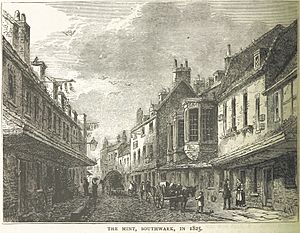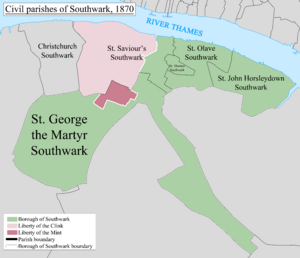Liberty of the Mint facts for kids
The Mint was a special area in Southwark, south London, England. It was located near where Marshalsea Road is today. This area got its name because King Henry VIII set up a place to make coins, called a mint, there around 1543. The mint was in a large house called Suffolk Place.
The coin-making stopped when Queen Mary I was in charge, and Suffolk Place was taken down in 1557. Later, in the late 1600s and early 1700s, The Mint became famous for something else. It was known as a "liberty", which meant it had its own rules. This special status offered a kind of protection for people who owed money and were trying to avoid being sent to debtors' prison.
Contents
A Special Place with Its Own Rules
In 1550, the City of London bought some land from Edward VI's government. This land included the former area of Bermondsey Abbey and the Archbishop of Canterbury's land. The king's mother had owned a large house called Suffolk Place (also known as Southwark Place) in this area.
When Queen Mary I became queen, she gave Suffolk Place to the Archbishop of York. The Archbishop then started renting out the land for building. Many small, crowded, and poor-quality homes were built there. This turned the area into a very poor and crowded neighborhood, often called a "rookery" or slum.
Because of the 1550 land deal, The Mint had its own special rules. It was separate from the control of the City of London. This created the Liberty of the Mint. This meant it became a place where people trying to escape the law, especially those who owed money, could hide. It was sometimes called an "Alsatia" after another similar area in London.
Life for Debtors in The Mint
The Mint attracted many people who owed money. If you were in danger of being sent to debtors' prison, you could try to hide in The Mint. However, once you were inside, you risked being arrested if you left its boundaries.
People who collected debts, sometimes called "duns," would wait on the main roads outside The Mint. They hoped to catch debtors trying to leave. These collectors could be regular bill collectors or even tough people who might hurt someone to get the money.
Life inside The Mint was very difficult. Since debtors couldn't leave (except on Sundays, when debts couldn't be collected), it was hard for them to find work to earn money. Those who tried to leave on Sundays to get money from friends or lenders were called "Sunday gentlemen." They would try to look rich to trick lenders into giving them money.
Many debtors in The Mint suffered from not having enough food or were even murdered before they could get enough money to leave. The area itself was unhealthy because it was lower than the nearby river. This meant it often had problems with sewage and dirty water, which caused many illnesses. The writer Daniel Defoe described life there for his character Moll Flanders in his famous novel.
The End of The Mint's Special Status
In 1723, The Mint lost its special protected status because of a new law called The Mint in Southwark Act 1722. At the same time, the law changed so that people who owed less than £50 could no longer be put in prison for their debts. This meant many residents could leave The Mint without fear of being arrested.
Even after losing its special status, the area remained a slum well into the 1800s. It was known as one of the poorest parts of London. While new roads were built in other slum areas to clear them out, Southwark Bridge Road, built in 1819, went around The Mint instead of through it.
In the late 1800s, The Mint's terrible living conditions were shown to the public. The Rev Andrew Mearns wrote about it in The Bitter Cry of Outcast London (1883), and George R. Sims wrote about it in How the Poor Live (1883). These writings caused a big scandal and led to a special investigation by the government in 1884–1885.
The destruction of The Mint was already happening. From 1881 to 1886, most of the slums were cleared away as Marshalsea Road was built. However, even in 1899, some parts of the old slum still remained.
The Mint in Stories and Today
The Mint is mentioned by many writers from the 1700s, including Alexander Pope and John Gay. It is also a hiding place for the outlaw Jack Sheppard in William Harrison Ainsworth's novel Jack Sheppard (1839) and in the novel The System of the World by Neal Stephenson.
Today, the only thing left that reminds us of The Mint is a street in the area called Mint Street.
See also
- The Marshalsea, a famous debtors' prison that was close to The Mint.



